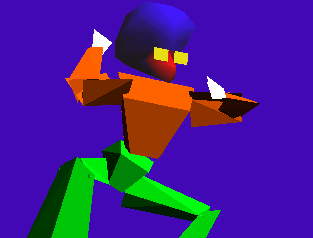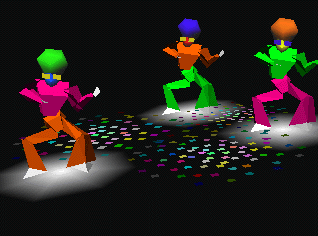3D Animation Workshop: Lesson 42: VRML For Web Advertising
|
|
Lesson 42 - VRML for Web Advertising - Part 1
Hold on to your hats, because we really have something exciting for you to see.
We've been talking about the interest in "embedded" VRML--small VRML windows in regular HTML Web pages--and the promise they may hold for breakthrough graphical content. There are so many new and important ideas to share in this lesson, I hardly know where to start.
Actually, I know exactly where to start. If you don't have a VRML browser installed on your system, go get one right now. If you don't have a VRML browser, you won't be able to experience the remarkable creative developments that we've assembled here. It's free and I can wait until you get back. Just go to the Cosmo Software site and download the new Cosmo Player 2.1. It's a short download and very easy to install. For those who don't have a VRML browser and don't have time to grab one right now, I've included screen shots. But you'll be missing the animation and the sound!
I went out in search of what the best creative talents are doing with embedded VRML, and my travels took me into the heart of that great digital arts capital--San Francisco. My first stop was at Mondo Media, a large and very impressive shop whose prestige rests fundamentally on high-end games work. John Evershed, principal and co-founder of Mondo, showed me a spectacular portfolio of 3D pre-rendered animation. This stuff was gorgeous. But the purpose of my visit was to discover what Mondo was doing with VRML, and to hear John's vision of the future of Internet graphics.
John is struggling to forge the basic concepts of viable Web-based entertainment. To make Web advertising more entertaining is one thing, but his greater vision is of entertainment products linked to advertising. John wonders whether the audience is really interested in better advertising, or rather in better entertainment which creates a vehicle for an advertising sponsor. He imagines a future (and not a very distant one) in which people will drop by a Web site for entertainment just as they turn on the television today, and he is working hard to develop content that makes commercial and technological sense for such sites.
But if Web advertising itself is to be made more compelling, John believes that banner ads must yield to "interstitials." These are the kinds of spots we already know from television, advertisements that seize the entire screen for some period of time. Interstitial spots can deliver sound because they are not competing with anything else on the screen, and John argues that sound provides 60 percent of the impact.
Mondo's "Dancing Dudes" piece is absolutely fabulous. When I first saw it at an event a month or so ago, the whole crowd broke into applause. It starts with a banner embedded in a regular web page.

When the user clicks on the characters, the music starts playing and they begin to dance. After a few seconds of dancing, the screen in replaced with an interstitial spot, and the animation continues in a larger frame.


Finally, the interstitial is replaced by the sponsor's home page.
If you have a VRML browser, CLICK HERE to see the real thing. And make sure you've got your speakers turned on. This will blow you away! Use your browser's "back" button to return to this page when you're done.
Let's move on to Part 2 for more examples.
| To Continue to Parts 2 and 3, Use Arrow Buttons |
|
Created: June 9, 1998
Revised: June 9, 1998
URL: https://webreference.com/3d/lesson42/


 Find a programming school near you
Find a programming school near you